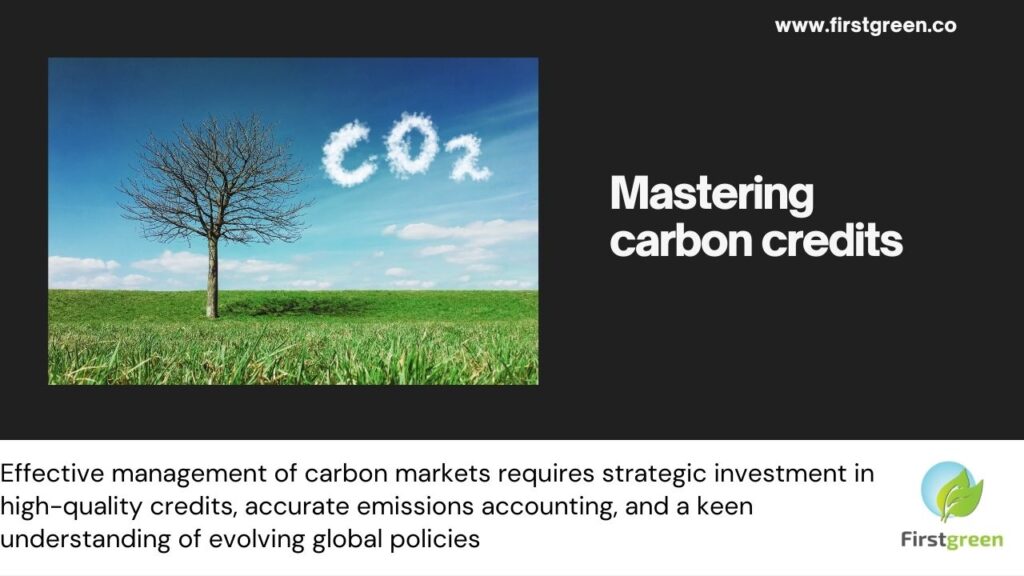Mastering Carbon Markets: Effective Strategies for Investing in Carbon Credits, Emissions Calculations, and Market Management

As the global community continues to intensify its efforts to combat climate change, carbon markets have emerged as pivotal tools in driving emissions reductions. Understanding how to effectively navigate both compliance and voluntary carbon markets, manage demand and supply dynamics, and address global policy shifts is crucial for any stakeholder in this space. This article explores these aspects, offering insights on the foundation for investing in carbon credits, calculating emissions, and managing market dynamics, with a focus on key regions including the USA, UK, Singapore, and Australia.
1. Foundations for Buying Carbon Credits
When considering the purchase of carbon credits, it’s essential to understand the basis on which these credits are valued. Carbon credits represent one metric ton of CO2 emissions reduced or removed from the atmosphere. Buyers should evaluate:
- Credibility and Certification: Ensure that credits come from certified projects that adhere to stringent standards such as those set by Verra or the Gold Standard. Certification helps ensure the credibility and effectiveness of the emission reductions claimed.
- Project Type and Impact: Assess the type of project (e.g., reforestation, methane capture, or renewable energy) and its environmental and social impact. High-quality projects often deliver additional co-benefits, such as biodiversity preservation or community development.
- Price Dynamics: Understand how market dynamics affect credit prices. Prices may fluctuate based on demand, project type, and market liquidity.
2. Calculating Scope 1, Scope 2, and Scope 3 Emissions
Accurate carbon accounting is crucial for understanding your carbon footprint and making informed decisions about carbon credit purchases. Here’s how to approach each scope:
- Scope 1: Direct emissions from owned or controlled sources (e.g., fuel combustion in company vehicles). Measure these emissions using direct emission factors for each source.
- Scope 2: Indirect emissions from the generation of purchased electricity, steam, heating, and cooling. Use emission factors provided by your energy supplier or national databases.
- Scope 3: All other indirect emissions that occur in the value chain (e.g., business travel, waste disposal). These can be challenging to measure but are often addressed through lifecycle assessments and supply chain analyses.
3. Managing Demand and Supply in Carbon Markets
Effective management of both demand and supply sides in the carbon market involves several key strategies:
- Demand Side: Stimulate demand through corporate sustainability goals, regulatory requirements, and voluntary commitments. Businesses can integrate carbon credits into their environmental strategies and corporate social responsibility (CSR) initiatives.
- Supply Side: Enhance the supply of high-quality credits by supporting innovative projects and ensuring that projects meet rigorous verification standards. Engage with project developers and certifiers to support transparency and integrity in the market.
4. Navigating Compliance and Voluntary Markets
The carbon market is divided into compliance and voluntary markets, each with distinct characteristics:
- Compliance Market: Driven by regulatory requirements, such as cap-and-trade systems or carbon taxes. These markets are typically more structured with stringent compliance rules. Key players include countries like Singapore, which has implemented robust carbon pricing mechanisms.
- Voluntary Market: Participants purchase credits voluntarily to offset emissions beyond regulatory requirements. These markets offer flexibility and innovation but require careful vetting of project quality.
5. Global Policy Dynamics
Policies shaping the carbon market vary significantly across regions. Here’s a snapshot of key areas:
- USA: The US has a patchwork of federal and state-level policies. Recent developments include the Inflation Reduction Act, which provides incentives for renewable energy and emissions reductions.
- UK: The UK has a well-established carbon pricing mechanism, including a carbon tax and the Emissions Trading Scheme (ETS), which align with its commitment to net-zero by 2050.
- Singapore: Singapore’s carbon tax, introduced in 2019, is a significant regulatory measure, pushing for both compliance and voluntary market participation.
- Australia: Australia’s carbon market includes the Emissions Reduction Fund (ERF), which supports various projects aiming for emissions reductions.
6. Policy Implications and Future Directions
As we move towards 2030 and beyond, global policies and market dynamics will continue to evolve. The convergence of compliance and voluntary markets, increased transparency, and innovative project types will shape the future of carbon markets. Key developments to watch include:
- Article 6 of the Paris Agreement: This article, focusing on international cooperation and market mechanisms, will be crucial for shaping global carbon trading and credits.
- Jurisdictional Programs: Increasingly, national and regional programs are aligning with global standards, potentially leading to a more integrated carbon market.
Conclusion
Navigating the carbon market requires a nuanced understanding of market dynamics, rigorous carbon accounting, and strategic investment in high-quality carbon credits. By staying informed about global policy shifts and managing both demand and supply effectively, stakeholders can contribute to a more sustainable and effective carbon market.
For organizations and individuals alike, engaging with the carbon market thoughtfully and strategically is essential for achieving meaningful climate action and ensuring long-term sustainability.